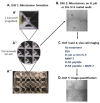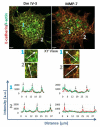Cleavage of the Perlecan-Semaphorin 3A-Plexin A1-Neuropilin-1 (PSPN) Complex by Matrix Metalloproteinase 7/Matrilysin Triggers Prostate Cancer Cell Dyscohesion and Migration
- PMID: 33809984
- PMCID: PMC8004947
- DOI: 10.3390/ijms22063218
Cleavage of the Perlecan-Semaphorin 3A-Plexin A1-Neuropilin-1 (PSPN) Complex by Matrix Metalloproteinase 7/Matrilysin Triggers Prostate Cancer Cell Dyscohesion and Migration
Abstract
The Perlecan-Semaphorin 3A-Plexin A1-Neuropilin-1 (PSPN) Complex at the cell surface of prostate cancer (PCa) cells influences cell-cell cohesion and dyscohesion. We investigated matrix metalloproteinase-7/matrilysin (MMP-7)'s ability to digest components of the PSPN Complex in bone metastatic PCa cells using in silico analyses and in vitro experiments. Results demonstrated that in addition to the heparan sulfate proteoglycan, perlecan, all components of the PSPN Complex were degraded by MMP-7. To investigate the functional consequences of PSPN Complex cleavage, we developed a preformed microtumor model to examine initiation of cell dispersion after MMP-7 digestion. We found that while perlecan fully decorated with glycosaminoglycan limited dispersion of PCa microtumors, MMP-7 initiated rapid dyscohesion and migration even with perlecan present. Additionally, we found that a bioactive peptide (PLN4) found in perlecan domain IV in a region subject to digestion by MMP-7 further enhanced cell dispersion along with MMP-7. We found that digestion of the PSPN Complex with MMP-7 destabilized cell-cell junctions in microtumors evidenced by loss of co-registration of E-cadherin and F-actin. We conclude that MMP-7 plays a key functional role in PCa cell transition from a cohesive, indolent phenotype to a dyscohesive, migratory phenotype favoring production of circulating tumor cells and metastasis to bone.
Keywords: dyscohesion; matrilysin/MMP-7; microtumors; migration; perlecan/HSPG2; prostate cancer.
Conflict of interest statement
The authors declare no conflict of interest.
Figures







Similar articles
-
Matrilysin/MMP-7 Cleavage of Perlecan/HSPG2 Complexed with Semaphorin 3A Supports FAK-Mediated Stromal Invasion by Prostate Cancer Cells.Sci Rep. 2018 May 8;8(1):7262. doi: 10.1038/s41598-018-25435-3. Sci Rep. 2018. PMID: 29740048 Free PMC article.
-
Matrilysin/matrix metalloproteinase-7(MMP7) cleavage of perlecan/HSPG2 creates a molecular switch to alter prostate cancer cell behavior.Matrix Biol. 2014 Jun;36:64-76. doi: 10.1016/j.matbio.2014.04.005. Epub 2014 May 14. Matrix Biol. 2014. PMID: 24833109 Free PMC article.
-
Perlecan/HSPG2 and matrilysin/MMP-7 as indices of tissue invasion: tissue localization and circulating perlecan fragments in a cohort of 288 radical prostatectomy patients.Oncotarget. 2016 Mar 1;7(9):10433-47. doi: 10.18632/oncotarget.7197. Oncotarget. 2016. PMID: 26862737 Free PMC article.
-
Molecular basis of semaphorin-mediated axon guidance.J Neurobiol. 2000 Aug;44(2):219-29. doi: 10.1002/1097-4695(200008)44:2<219::aid-neu11>3.0.co;2-w. J Neurobiol. 2000. PMID: 10934324 Review.
-
Perlecan signaling: helping hedgehog stimulate prostate cancer growth.Int J Biochem Cell Biol. 2006;38(11):1855-61. doi: 10.1016/j.biocel.2006.03.022. Epub 2006 Apr 25. Int J Biochem Cell Biol. 2006. PMID: 16750652 Review.
Cited by
-
The Potential of Extracellular Matrix- and Integrin Adhesion Complex-Related Molecules for Prostate Cancer Biomarker Discovery.Biomedicines. 2023 Dec 28;12(1):79. doi: 10.3390/biomedicines12010079. Biomedicines. 2023. PMID: 38255186 Free PMC article. Review.
-
Gabapentin Disrupts Binding of Perlecan to the α2δ1 Voltage Sensitive Calcium Channel Subunit and Impairs Skeletal Mechanosensation.Biomolecules. 2022 Dec 12;12(12):1857. doi: 10.3390/biom12121857. Biomolecules. 2022. PMID: 36551284 Free PMC article.
-
Identification of a basement membrane gene signature for predicting prognosis and estimating the tumor immune microenvironment in prostate cancer.Aging (Albany NY). 2024 Jan 17;16(2):1581-1604. doi: 10.18632/aging.205445. Epub 2024 Jan 17. Aging (Albany NY). 2024. PMID: 38240702 Free PMC article.
-
Bone Marrow Endothelial Cells Increase Prostate Cancer Cell Apoptosis in 3D Triculture Model of Reactive Stroma.Biology (Basel). 2022 Aug 26;11(9):1271. doi: 10.3390/biology11091271. Biology (Basel). 2022. PMID: 36138750 Free PMC article.
-
Microarray profiling identifies hsa_circ_0082003 as a novel tumor promoter for papillary thyroid carcinoma.J Endocrinol Invest. 2023 Mar;46(3):509-522. doi: 10.1007/s40618-022-01922-3. Epub 2022 Sep 17. J Endocrinol Invest. 2023. PMID: 36115894
References
-
- Grindel B.J., Martinez J.R., Tellman T.V., Harrington D.A., Zafar H., Nakhleh L., Chung L.W., Farach-Carson M.C. Matrilysin/MMP-7 Cleavage of Perlecan/HSPG2 Complexed with Semaphorin 3A Supports FAK-Mediated Stromal Invasion by Prostate Cancer Cells. Sci. Rep. 2018;8:7262. doi: 10.1038/s41598-018-25435-3. - DOI - PMC - PubMed
-
- Grindel B.J., Martinez J.R., Pennington C.L., Muldoon M., Stave J., Chung L.W., Farach-Carson M.C. Matrilysin/matrix metalloproteinase-7(MMP7) cleavage of perlecan/HSPG2 creates a molecular switch to alter prostate cancer cell behavior. Matrix Biol. 2014;36:64–76. doi: 10.1016/j.matbio.2014.04.005. - DOI - PMC - PubMed
MeSH terms
Substances
Grants and funding
LinkOut - more resources
Full Text Sources
Other Literature Sources
Medical

